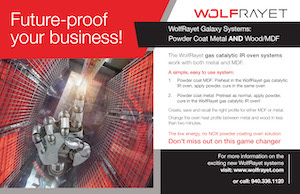Many anodizers over the years — maybe a majority — have switched to anodizing by current control (current density) instead of voltage control when anodizing most of the common aluminum alloys in the 3000, 5000, and 6000 Series.
 Larry ChesterfieldThey understand that for most loads of Type II and Type III (hardcoat) anodizing, using current control results in achieving the desired coating thickness in less time than when using voltage control. The ability of computer software to calculate the surface area of parts has all but eliminated the task of hand-measuring and calculating the surface area.
Larry ChesterfieldThey understand that for most loads of Type II and Type III (hardcoat) anodizing, using current control results in achieving the desired coating thickness in less time than when using voltage control. The ability of computer software to calculate the surface area of parts has all but eliminated the task of hand-measuring and calculating the surface area.
There are still anodizers that use voltage control to anodize their parts. Sometimes, using constant voltage control works all right. This is mainly when Type II anodizing is being done on loads that will not run very long, say 30 minutes or less. Usually, on this type of load, the coating thickness requirement is less than 0.7 mil, and the coating can form in a reasonable amount of time without the voltage decaying more than a volt or two during the run. When this approach is used, the only way there is to predict the running time is by past experience – also known as “trial and error.”
Amperage Builds The Anodic Coating
In the anodizing process, it is the current (amperage) that builds the anodic coating. As the coating builds up on the parts, the non-conductive anodic coating impedes the flow of current. If the current is fixed throughout the anodizing cycle, the time required to build the desired coating thickness can be predicted. With the amperage fixed, the voltage is free to rise to whatever level is required to overcome the resistance to current flow as the coating increases in thickness.
If the voltage is fixed and the amperage is allowed to roam freely, the increasing resistance of the coating build-up will cause the current to drop gradually during the cycle. It can be seen that if the amperage is constantly dropping, it will take longer to get the desired coating thickness. Furthermore, there is no way to predict how long to anodize the load because the variable that builds the coating, amperage, is constantly changing. Yes, if there is an ampere-hour meter in the circuit, the load could be run to a predetermined amp-hour total if that value is known. Yet, it would still take longer to anodize the load to the desired coating thickness.
Rules of 720 and 312
By using amperage control (“anodizing by current density”), the amperage is fixed for the entire anodizing cycle, providing a “constant current density” for the entire length of the cycle. If the current is constant, the cycle time required to achieve the desired coating thickness can be calculated. This can be done with the help of the following well-known formula(s):
- Rule of 720: Minutes to anodize = [mils (of coating desired) x 720] / amps per square foot (current density)
- Rule of 312: Minutes to anodize = [microns (of coating desired) x 3.12] / amps per square decimeter (current density)
These equations can be manipulated to give the coating thickness if you know how long you want to anodize or the current density required to achieve a certain coating thickness in a given amount of time.
Anodizing by current density is a little more trouble because the surface area of the parts (and the rack, if aluminum) needs to be known. The payoff is usually worth the trouble of calculating the surface area of the load.
The anodizing cycle is shortened, even if by only a small amount, and the anodizer actually has control of the process. If the surface area is unknown, it can be calculated for most extrusion loads by using the perimeter stated on the print. Sometimes, the part has to be measured and the surface area estimated. If the surface area can be calculated to within 10%, or so, of the actual, it will still work.
Larry Chesterfield is President and CEO of Anodizing Technologies, Inc. He has experience in a job shop performing anodizing, painting, and fabrication and now offers equipment systems design and build, anodizing technical expertise, and operations/process troubleshooting. Visit anodizingtechnologies.com or email him at larry@anodizingtechnologies.com





































